Foundation for Education, Ecology and Livelihood
Report on operations
(March 2014 – December 2018)

Table of Contents
An introduction to the organization
Working of the sanctuary schools
Environment Education programs
Activities of the Environment Education program
Outreach to government schools
Activities in Immadihalli school
Activities taken up as part of Biodiversity conservation
Researching and supporting sustainable livelihoods
Activities for supporting the Kaigal Trust
An introduction to the organization
Environmental degradation and its effect on all life on the planet is one of the greatest challenges that human society faces today. Forests and wilderness the world over are under great stress and saving and increasing biodiversity is an urgent concern. Responding to this challenge, and educating for a sustainable development involves working in several dimensions – skills, livelihoods, ecology, communities, equity and justice. In a large, heterogeneous diverse country like India, hierarchies of caste, economic conditions and gender inequalities pose additional constraints.
Foundation for Education, Ecology and Livelihood (FEEL) was registered as a Public Charitable Trust and was set up a group of likeminded individuals – educationists by background – to address the challenges of environmental degradation and that of sustainable rural development. The overarching objective was the supporting of life-serving and ecologically restorative education. The organization was set up in 2014 to formalize and take over the running of the Kaigal Education and Environment Program of the Krishnamurti Foundation India. The Kaigal Education and Environment Program, has been working as a curricular outreach program of the Krishnamurti Foundation India since 2002 and has been working in tribal and rural communities adjoining the Kaundinya Wildlife Sanctuary in Chittoor District of Andhra Pradesh.
An overview of the activities
It is with a great deal of satisfaction that the Trustees present the first report for the Foundation for Education, Ecology and Livelihood for the period March 2014 – April 2018[1]. The areas of our work include education – through tribal schools and education and environment programs – conservation and community empowerment through sustainable livelihood options.
Conservation remains the key focus area of the Trust and we have documented the local biodiversity along with efforts to maintain and restore the local environment. FEEL worked with the local panchayat biodiversity management committees to strengthen the communities’ understanding of local ecology and ways to manage it sustainably and has built a partnership with the National Biodiversity Authority. Recognizing that sustainable livelihoods are a key for conservation, FEEL has been supporting research and skill development for livelihood opportunities for the communities based on local bio resources. The livelihood enterprise, Kaigal Trust is on it way to becoming more self-reliant, through an upscaling and skill development program, funded by the UNDP, Small Grants Program. The community supported Sanctuary schools have become oases for learning, with enrolment increasing and older students returning to teach the younger ones, holding the promise of a sustained educational change. Our efforts in integrating environmental science understanding into the school activities and through the school to the community is helping the development of an ecologically responsive curriculum.

Illustration 1: Nursery of indigeneous trees maintained at Kaigal
|
Key outcomes
|
Even as we are encouraged by the progress, the challenges of today’s changing economic and societal structures are being felt in the communities in all aspects – resources, education and local enterprise. Our efforts in FEEL are continually in this direction, of strengthening the local communities and capabilities, to respond to the changes around them. The areas of our work for this year and going forward will be in terms of building skills and capabilities within the community, strengthening the operations of the livelihood enterprise and enhancing the school education program to build skills that will allow them to interface with the changing world. We would need to network with other organizations to help build a coalition that can shape responses to the challenges now being faced. Knowledge building and sharing will be a key focus of our operations this year and we will seek to work with other institutions in the areas of education and conservation to develop holistic education models and sustainable development paradigms. It is our vision to develop the organization as an integrated Centre for Rural Development, Research and Capacity Building. The following sections describe, in detail, the different areas of work.
Education programs
The work of the organization in the area of education has been along three areas:
- Schools for tribal children, the Sanctuary Schools
- Environment Education programs for other schools
- Outreach to government schools
Working of the sanctuary schools
In a stratified society like India, divided along caste, socio-economic, linguistic lines, educational attainments vary widely. While curriculum frameworks in India have spoken about the lived experiences of the students as a learning input, in practice, learning has often been restricted to the textbook. Students in marginalized contexts like the tribal villages where we work in often find schools an alienating experience.
It is in this socio-economic and educational context, that the Kaigal Education and Environment Program set up informal schools as learning centres in 5 tribal villages; these were subsequently formalized as two registered primary schools in the villages of Kalligutta and Mugilupodalarevu. Both the schools are registered under the Right to Education Act (2009) and are staffed by qualified teachers. All the teachers have finished their graduation followed by a B.Ed degree. They either belong to the community or are from the neighborhood.
Ever since the setting up of the Trust in March 2014, FEEL has been guiding the schools in the planning of daily operations, development of age-wise curriculum and resource materials as well as in teacher professional development. The functioning of the schools has been supported by donations from individuals and institutions.
The primary areas of responsibility of FEEL towards the schools are:
- Supporting teacher development of the schools
- Providing operational and administrative support for the schools
- Developing learning materials for the students and teachers
- Developing the schools as community resource centres for the education of the tribal and rural communities around
- Supporting and managing the fund raising activities for the continued running of the schools
Over the years the schools have grown in their operations in Kalligutta and Mugilupodarevu. The number of pre-school children attending school has increased steadily, suggesting that the community is stable and thriving.
Guiding principles of the Sanctuary Schools
- A curriculum that has integrated the care of, and responsiveness to, the local ecology and environment, where the community elders share their knowledge of the local ecology as part of the school learning.
- An environment of learning, free from fear or reward, with an integrated approach to art, craft and other school subjects, along with exposure to skill development in indigeneous skills
- Teacher development programs that takes into account their lived experiences and supporting and mentoring their professional development on a continuous basis
- Health-care and hygiene is an integral part of the program. Children are provided with a nutritious mid-day meal; yoga and exercises are part of the daily routine in school. Children are provided medical help when ever needed.
Activities of the school
- The teachers are trained to develop their own materials, contextualized to the learning needs of each individual child. The classrooms are structured as mixed age groups and the teachers are assisted by the older students teaching the younger ones. Upto age 7, the students work with customized materials developed in the school. After age 8, they work with the state textbooks as well as additional resources developed by the teachers. Materials have also been procured and developed for the pre-school age children.
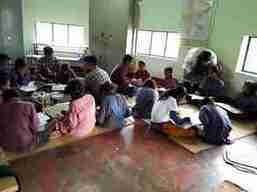
Illustration 2: Students working on a review
- An integrated approach has been demonstrated for bringing in environmental concerns into the regular school curriculum, through participation in an international program, called the Eco-schools program.The eco-schools program provided an opportunity to integrate the academic learning to the context of the forest and the village and therefore was considered very appropriate for young students from this tribal village.

Illustration 3: Community exhibition from waste and recycled materials
Different modules for water management, biodiversity management, energy management and waste management were designed and implemented with the community; the Kalligutta school became an International Eco school for its work during the academic year 2014-15 and has continued to maintain the focus on environment education.
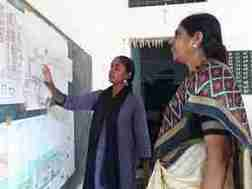
Chandrakala, our oldest student, explaining the mapping exercise to the Kadapanatham High School HM
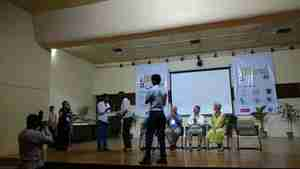
Illustration 4: School receiving the Eco schools award
- The school based academic work has been supplemented with inputs from resource persons who visit the schools regularly to interact with the students. These have ranged from art workshops, to creative writing to science through toy making. Students have also visited places in Bengaluru as a part of their exposure to other learning environments. During the year 2016-17, art teachers from Rishi Valley worked with the senior students of the schools to stage a dance ballet. During 2017-18, students were introduced to digital learning possibilities and students went to the local market and made a project presentation on the local market to the parents.
- Community interactions to share about the working of the school continues to be an important activity of the school. Regularly scheduled community meetings help the school and community to remain connected on an ongoing basis. Formalizing their local knowledge into the curriculum means that the schools become natural places for learning, relevant to the community.
- The primary objective of the Sanctuary Schools is to provide a meaningful and relevant educational experience for the children from the communities, without removing them from their context. The students learn in mixed age groups and lessons are planned by the teachers according to the levels of the children.

Illustration 5: Forest study with traditional healer
- In addition to mathematics and Telugu instruction, this year saw the introduction of spoken English for the students, with the use of multimedia resources. The older students are taking a lead in this aspect – learning and teaching the young ones. In addition to this, the students who have completed/ participating in the NIOS program are learning basic digital skills. The teachers have also been introduced to basic digital skills.
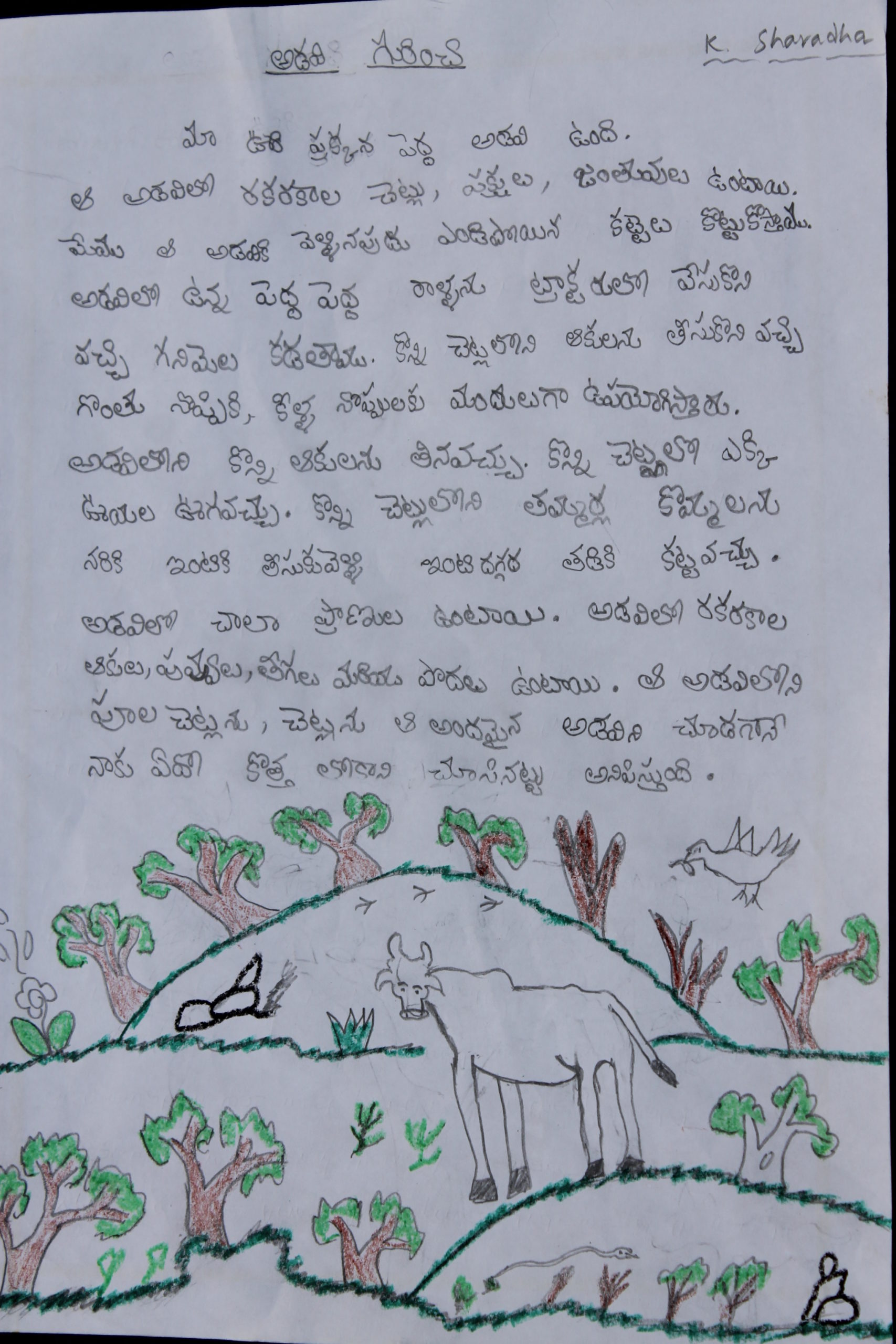
Illustration 6: Picture story by a student
- Science Day 2018 – As a part of our initiative to bring schools and communities together for science and environment education, a science day was organized in two clusters during November 2018. Students from The Valley School and several government schools also participated. The students from the Sanctuary Schools presented many hands-on projects as well as some investigative projects. The event was well-attended by local schools, community members, education department officials and the press; the Eenadu carried a news coverage of the event.
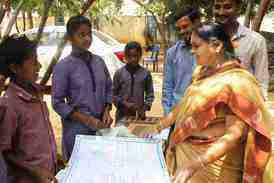
Explaining the biodiversity documentation to the MEO
- Digital story telling – Students undertook a digital documentation of the health and sanitary condition around the villages and nearby areas. They took photographs, interviewed villagers and captured people’s understanding of health and hygiene. Many of the projects as well as their regular work during school was shared in community meetings and open houses with parents. The community meetings have been well attended and parents have been showing continuing interest in the school activities.
- We have observed over the years that it is important to educate the community as well for a sustained educational attainment for the students. In the increasingly market-driven development model, tribal communities need to be empowered to evaluate information and make decisions; all of which require functional levels of literacy and numeracy. The community members have also expressed and articulated such a need for their learning. During this year, the community resource centers began to operate in the two schools. Using a variety of methods – story telling, digital resources and discussion, we have been working with the community on building awareness of different social, economic, and political issues besides building their literacy and numeracy. A skill building program is also being developed for the centres.
Outcomes
- Autonomy for the schools to develop a learning program, contextualized to the local environment and sensitive to the community needs have helped to create an inclusive learning environment. In the sanctuary schools, there are no drop-outs and the students continue their learning paths.
- Over the years the schools have grown in their operations in Kalligutta and Mugilupodarevu. All children above 3 years of age in these villages come to schools. At the end of Class 5 (the level upto which we are registered) many of them continue their studies by joining a Government High School – day school or residential. Some older children in the villages – who had not continued their education with government schools or had dropped out – enrol with the National Institute of Open Schooling to finish their Class 10 and 12. These students are mentored by the teachers to complete the exam and some continue their education through vocational, diploma or college degree programs.
- All children between 3 and 12 years of age in the two villages – Mugilupodarevu & Kalligutta – are now attending schools. During 2018, 5 students completed their secondary school examination (Class 10) and 1 student completed the Class 12 examination through the NIOS (May 2018). 4 of the students are continuing their education – one girl student is pursuing Class 12 with the Sanctuary School support, 2 boys joined ITI and 1 girl has joined a nursing diploma program. One of the students has joined the school as a teacher assistant and is pursuing her undergraduate degree program through a distance learning program.
- The age at marriage for girl students has been continuously increasing in the communities; this is significant from the point of view their health, the health and educational attainment of the community. Now the girls get married only when they are more than 20 years old and it is the mothers who opt for their child’s continued education in high schools and college.
- Over 30 students have completed their Class 10 exam through the National Institute of Open Schooling; 10 students have gone on to study in colleges.
Environment Education programs
The objective of the Environment Education Program is to sensitize schools, students, teachers and other educational institutions to the environment that we all are a part of. The program provides an opportunity for individuals to live close to nature in simple living conditions; to work hands-on for different activities, re-connect with the environment and is an attempt to understand our relationship with the natural world directly. The activities and experiences offer young minds an opportunity to observe and appreciate the beauty and order that exists in the natural world and are designed to create sensitivity, respect and a sense of wonder toward all life forms. The programs are designed based on the age of the students, the time of the year and the prevailing weather and environment conditions.
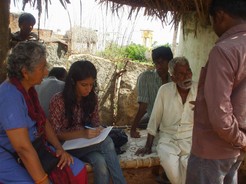
Illustration 7: Knowledge documentation from local healer speacializing in healing animals
The program design, co-ordination is done by FEEL with support from the Sanctuary School teachers and the Kaigal Trust members. The programs are of different durations and depend on the nature of the group students, interns or teachers. The content of the program is dependent on the needs of the group. Participants, especially the students from urban schools, become more sensitive to ecosystems, more aware and accepting of different life forms and get over their fear of wild life. This has allowed them to experience the natural world and the beauty of nature. They realize that the threat to forests and natural ecosystems is very real and that every individual should be actively involved in conservation. The program involves substantial interaction with the adults in the villages as well as the children itn the Sanctuary schools. This has significantly helped in breaking down class barriers, in generating awareness and acceptance of differing lifestyles and learning to live frugally with minimal resources.
Activities of the Environment Education program
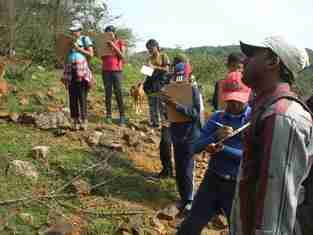
Illustration 8: Forest survey
Some of the activities undertaken under the Environment Education program are listed below. These have been designed for being conducted by students to allow them to learn through experience, different aspects of ecology and environment conservation.
- Maintaining the herb garden, nursery and land at the Kaigal Conservation Centre through different soil and water management and planting activities

Illustration 9: Farming in Kotrepalli
- Supporting the local communities in the maintenance of their water bodies
- Working under the supervision of local farmers to get a first hand exposure to farming
- Undertaking energy audit of local villages to understand the energy use during cooking and to design and install fuel efficient cooking stoves
- Conducting land use survey to identify land use patterns in the local communities.
Outcomes
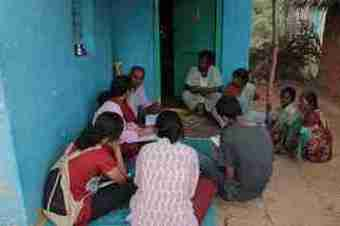
Illustration 10: Energy survey at M Kottur Village
- Demonstrating to the students and teachers a method of engaging with the environment with respect and conservation as the key stone
- Students and teachers have benefitted from participation in these larger community development programmes
- Strengthening of the identity of the Sanctuary School teachers and Kaigal Trust members as local knowledge holders
- Development of a hands-on environment education module that is adaptable to different age groups of students
- Over 2000 students from over 12 institutions have participated in these programs over the years
Outreach to government schools
One of the initiatives undertaken by FEEL was to explore how the learnings from our work at Kaigal could be shared with the public school system. FEEL entered into a collaboration with IT for Change to bring its experience and learnings to the public school system, using digital technologies. An academic intervention program focused on whole school development was taken up at Immadihall Government High School in 2014-15. The objectives of the programme were to create meaningful learning experiences for the students, develop teacher competencies to sustain a quality education programme, strengthening school based academic processes and connecting the teachers with communities of teachers at the district and state levels.
Activities in Immadihalli school
- Teacher capacity building for material creation using digital technologies
- Classroom level demonstration for using materials for multi-level teaching-learning
- Organizing enrichment activities for the students and teachers through a summer camp
- Reflective sharing workshops with teachers to discuss the aims and methods of education
Outcomes
- Demonstration of classroom processes and technology integrated lessons that are more interactive and involve students in learning; significant increase noticed in student interest
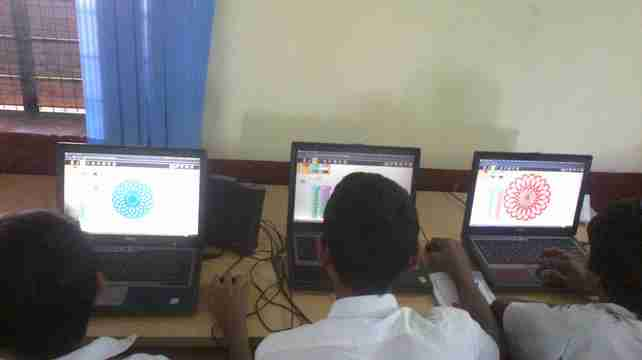
Illustration 11: Visual programming
- Teachers capacities built in the use of materials, including digital resources for transacting a multi-level classroom
- Development of resources in Mathematics and Kannada
Community led conservation
Conservation has been at the core of or vision at FEEL and we have been working at the village, panchayat, district and state levels to document local biodiversity, in addition to continuing insitu conservation practices at the Kaigal Conservation Centre. Ever since the program began at the Kaigal Conservation Centre, the program has focused on habitat restoration, maintaining a germ plasm of local indigeneous plants, maintaining a forest nursery and regeneration of endangered species. A participatory approach with local communities and sustainable use of forest resources have been at the cornerstone of our conservation program.

Illustration 12: Assisting FRLHT in PBR documentation at Kangundi
Activities taken up as part of Biodiversity conservation
While the conservation efforts have been going on since 2004, some key activities were taken up during the last three years to create and document local knowledge on conservation and sustainable livelihoods.
- Connecting with the local (Yanadhi) communities and conducting a Field Study and Documentation of sustainable harvesting practices of the communities in 32 tribal villages on the fringes of the Kaundinya Wildlife Sanctuary
- Afforestation and raising forest and medicinal plants nursery through partnership with educational institutions
- Conservation and augmentation of NTFP species through continuous updating of germ-plasm bank
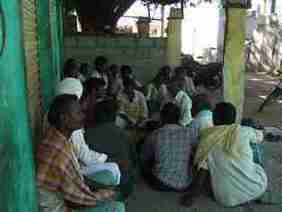
Illustration 13: Community meeting at Theertham
- Initiating a long term documentation of flowering and fruiting records of selected species of Non Timber Forest Produce (NTFP)
- Documentation of biodiversity and traditional knowledge systems – Peoples’ Biodiversity Register and Tradable Resources preparation.
- Establishing and capacity building of Biodiversity Management Committees in 5 Panchayats
Outcomes
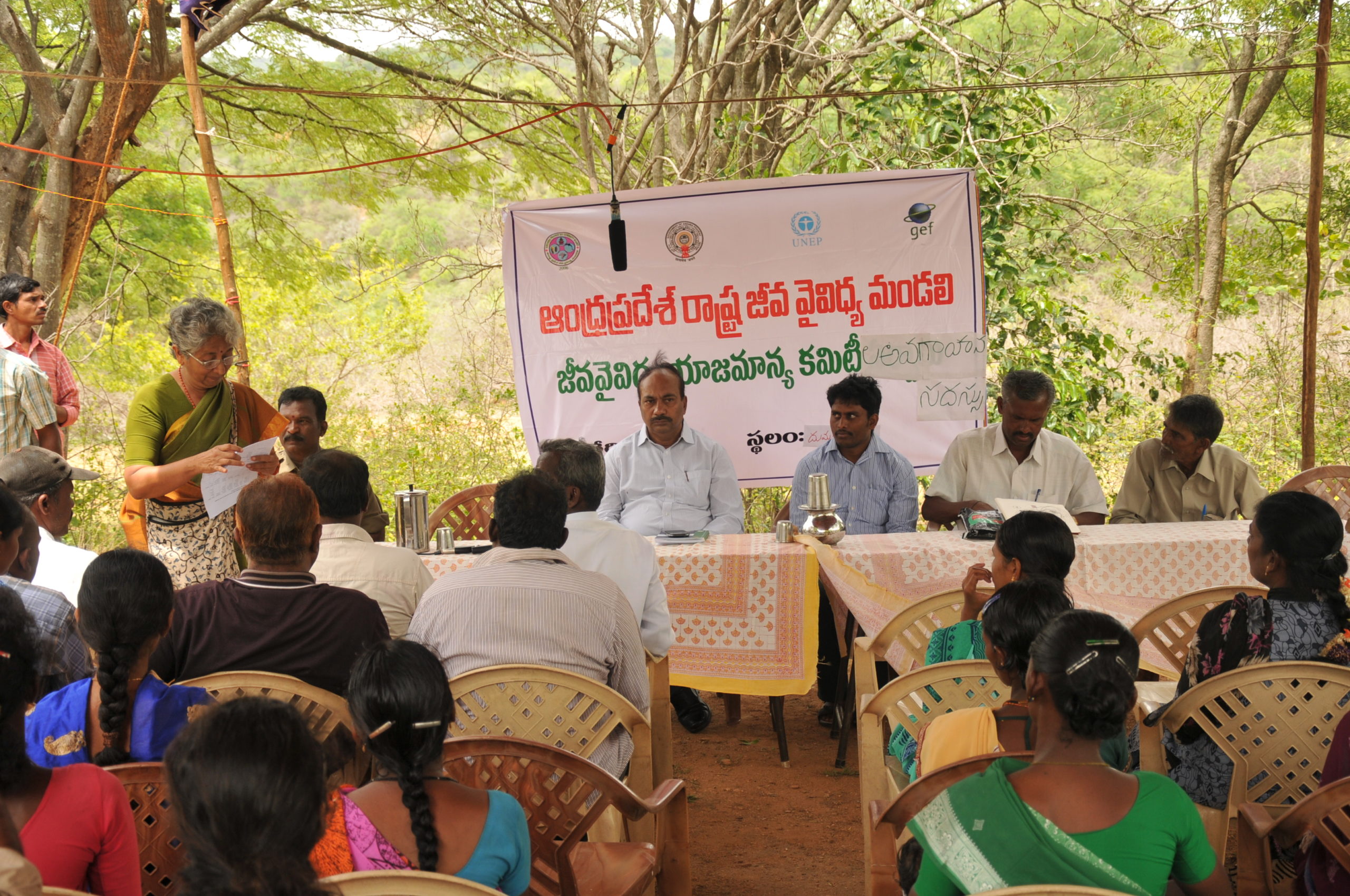
Illustration 14: Consultative meeting of APSBB
- Documentation of sustainable harvesting practices of the Yanadhi tribal community, across 32 villages, from 21 panchayats across 7 mandals
- Creation of BMC in two panchayats and awareness about access benefit sharing of NTFP
- Creating linkages between the BMC and the Andhra Pradesh State Biodiversity Board, Karnataka State Biodiversity Board, Forest Department Chittoor, BMC members from 2 panchayats as well as community representatives
- Development of Tradeable Resource Data for Chittoor District
With a new initiative from the National Biodiversity Authority, an interaction with the local Biodiversity Management Committees (BMC) was organized at the Kaigal Conservation Centre in July 2018. Members from the Ministry of Environment and Forests and the NBA and Andhra Pradesh State Biodiversity Board interacted with the communities as well as BMC members. The efforts of the Kaigal Education and Environment Program in mobilizing communities and establishing the formation of BMC was highly appreciated by the MOEF and the NBA.
Researching and supporting sustainable livelihoods
Over the years of the program, the community enterprise at Kaigal has taken root providing many disadvantaged women and youth an opportunity for a meaningful livelihood. FEEL has been attempting to bring together livelihoods and conservation through community led processes of documenting sustainable harvest practices, researching on ecologically responsible processing and capacity building of the local communities in procuring, processing, packaging and sale of products. Guided by FEEL, the community enterprise has become capable of managing its operations independently and is on its way to becoming a financially viable entity. The linkages built with the biodiversity authorities and the development of tradeable resource data have been critical in supporting the community enterprises with correct information on how to procure, process and price products.
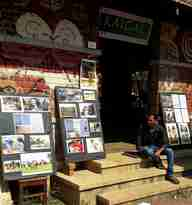
Illustration 15: Preparing for a sale
Activities for supporting the Kaigal Trust
Illustration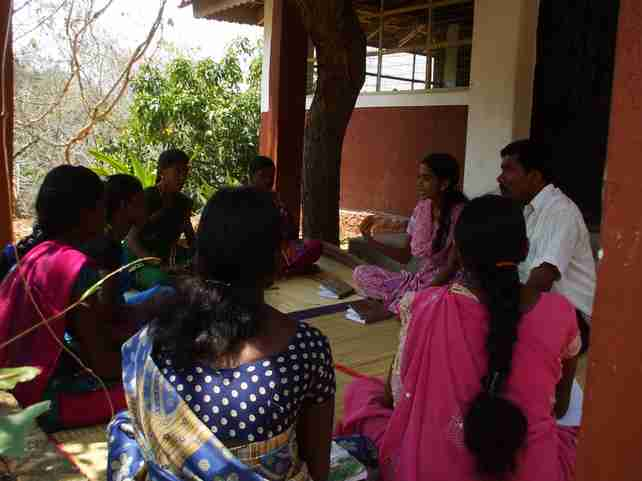
17: Capacity building of core team members
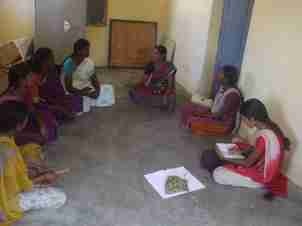
Illustration 16: Formation of self help groups
- Conceptualizing and guiding the upscaling effort of the Kaigal Trust, funded by the UNDP, GEF, in collaboration with Krishnamurti Foundation
- Co-ordinating the capacity building efforts of the core team at Kaigal Trust and community members from villages where products are sourced
- Researching value addition processes for NTFP to improve marketability
- Supporting the Kaigal Trust team by providing inputs on managing operations, finances and marketing
- Helping the Kaigal Trust develop alliances with other organizations and outlets for sale of its products
Outcomes
- Development of the Kaigal Trust community enterprise as a viable, independent entity with a turnover of Rs 25 lakh the financial year 2017-18
- Capacity building in core team and community members on sustainable harvesting and value addition methods
- Empowered group of women and youth who are developing skills of managing their own enterprises
- Demonstration of a model of Access Benefit Sharing through a community enterprise
Directions for the future
- Development of community learning and resource centres in select villages around the area. These centres will focus on building functional literacy, numeracy, citizenship education as well as build skills for livelihood. It is the vision of these centres that they become spaces for continuous learning for the community where they learn to engage with and act on different issues around health, conservation, livelihoods and education.
- Establish the organization as a field centre that can demonstrate models as well as train similar organizations on community supported models of sustainable livelihoods and biodiversity conservation
- Supporting the establishment of a rural development centre for skill building and contextually relevant education that will support the documentation, dissemination and fair use of traditional knowledge systems as well as mobilising the local community and building awareness on biodiversity conservation and management
- Building the environment education program to reach more institutions (educational and non-educational) so as to build a larger awareness around issues of conservation and education.
- Working with the educational administration and structures within the government to share some of the innovative approaches tried in the Sanctuary schools with government schools.
- Partnering with other organizations to bring our ideas and experiences of holistic education to more and more institutions within the government education system.
- Building linkages and sharing learning across similar endeavours is something we recognize as important. We have consciously made efforts to build linkages across academia, government and non-government sectors and in the coming years, we will seek to deepen our work in this area
- Establish the area in Kaigal as a station of field research in collaboration with academic institutions and other similar organizations and share the knowledge to strengthen the functioning of the local biodiversity management committees at the Panchayat level
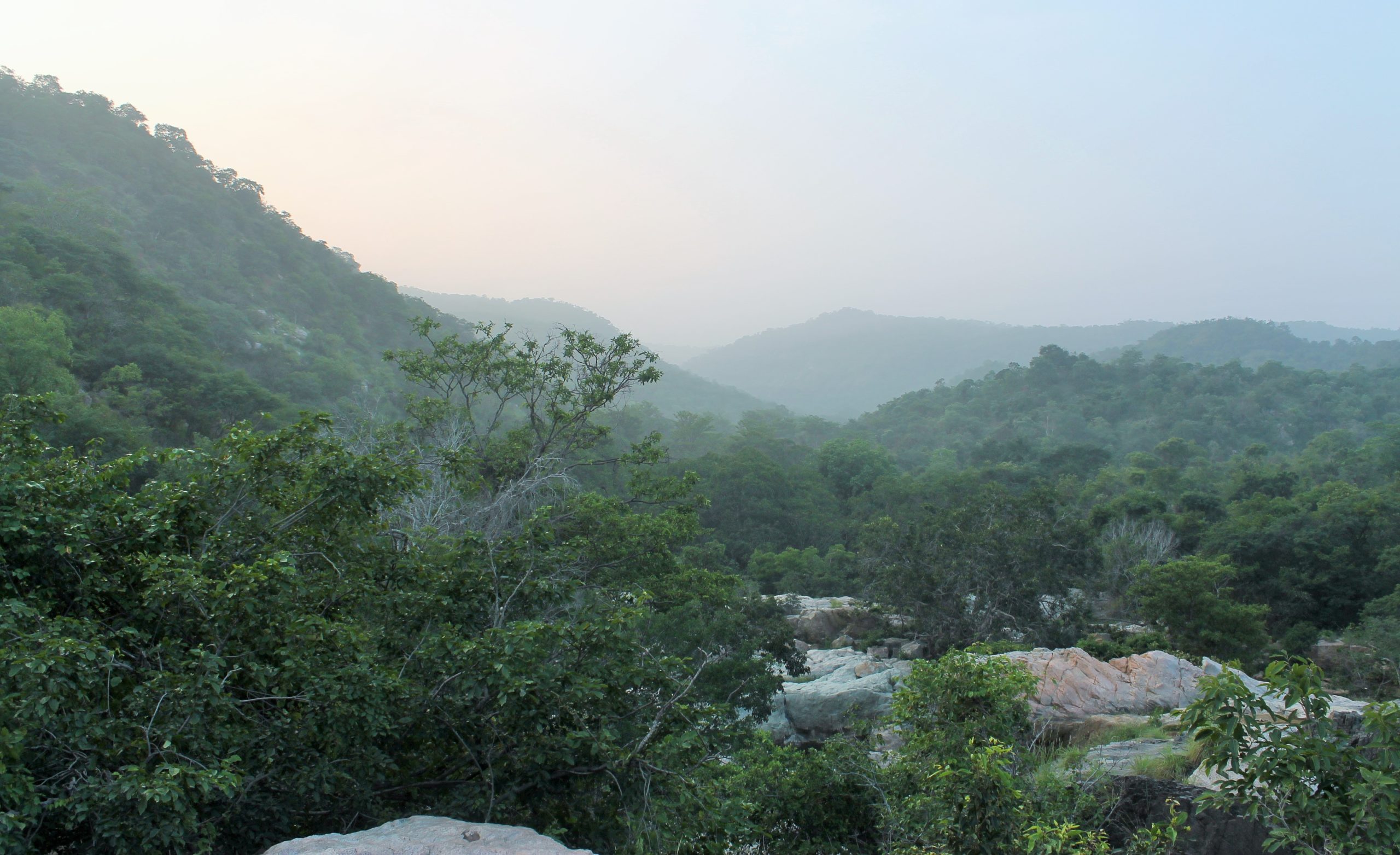
-
Though FEEL has been in operation from 2014, it implements the Kaigal Education and Environment Program which began in 2003, as a curricular outreach program of the Krishnamurti Foundation India ↑
